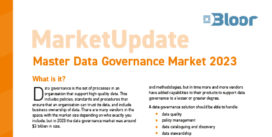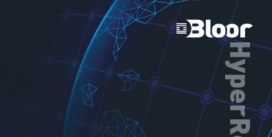TopQuadrant
Last Updated:
Analyst Coverage: Daniel Howard
TopQuadrant is a privately held software company. It is based in Raleigh, North Carolina, and was founded in 2001.
TopQuadrant TopBraid EDG
Last Updated: 14th July 2020
TopBraid Enterprise Data Governance (EDG) is a data governance platform built on RDF knowledge graphs. It is available in four modular packages: Metadata Management, Reference Data Management, Vocabulary Management, and Business Glossaries. The former three provide specialist capabilities for governing technical metadata, reference data, and taxonomies and ontologies, respectively. Business Glossaries adds its namesake, and is included in Metadata Management. Several add-on modules are also available. TopBraid Tagger and AutoClassifier, which provides automated tagging and classification, and TopBraid Explorer, which offers read-only access at a budget price per user, are particularly notable.
Customer Quotes
“TopBraid EDG–VM is… enabling Kennisnet to make significant progress toward our goals –where all kinds of systems are integrated and all information needed for delivering education tailored to an individual student is available to everyone.”
Kennisnet
“Using this system gave us the freedom to create relationships between our existing vocabularies and helped us transition our existing websites into one primary source of information.”
Mayo Clinic
The core component of TopBraid EDG is the knowledge graph, which is used to represent the data and metadata assets you hold within a particular knowledge domain. It also captures the relationships between those assets, and allows you to make inferences based on these relationships. In the same way, you can apply business rules that take advantage of this relationship structure. Multiple graphs (and thus multiple domains) can be connected together, and they can self-compose. You can also connect to a public knowledge graph and use its information to enrich your own.
The knowledge contained in your graph (or graphs) is exposed via the platform itself, allowing you to view, edit and govern your knowledge assets. The relationships between your assets are particularly emphasised: for example, asset views provide hyperlinks to all related assets. Governance assets, such as personalised dashboards, metrics, policies and so on are also included as part of these knowledge assets. Workflows are supported, and several workflow templates come pre-installed. Visualisations are available in the form of the LineageGram, an interactive lineage view (shown in Figure 1) that includes physical and logical data flows, and the NeighborGram, a graphical view of the relationships between your business terms and data assets (Figure 2). Search access is provided to all assets, as is a full audit trail, and the product boasts a number of features that promote ease of use and collaboration, including a personalisable, drag and drop, panel-based UI, an asset basket, the ability to create and share asset lists, commenting and tasking.
Assets are organised into asset collections, over 300 of which may be provided out of the box depending on the packages you have purchased. You can customise the structure of your collections via ontologies, and, with the Data Graphs add-on module, create your own types of asset collection. The provided ontology editing and management capabilities even allow you to manually govern the knowledge graphs that underpin the platform itself, offering extreme flexibility and customisation. Role management and role-based views are provided, and can be configured separately for individual assets, groups of asset collections (‘governance areas’), and for the platform as a whole.
The product also provides substantial automation capabilities, including scheduled importing and automated cataloguing; automatic discovery of information and connections (such as dependencies) present in your data; the automated extraction of business rules implicit in your data using machine learning; and the use of business rules to infer connections between your business terms and your data assets. Data quality can be checked automatically using your business rules, and the product will suggest fixes for each failed check. Moreover, the Tagger and AutoClassifier add-on module will automatically tag and classify your data using machine learning. When the module is properly trained, this includes unstructured data (documents, for example), thus enabling integrated governance of both structured and unstructured information.
Finally, TopBraid EDG provides API support across a wide variety of integration points. This includes SPARQL and GraphQL endpoints, with the latter in particular enabling complete retrieval of model structure, write access via mutation, and support for introspective querying. Moreover, TopBraid EDG will automatically generate your GraphQL schemas, and also leverages SHACL in conjunction with GraphQL to create what TopQuadrant describes as “semantic GraphQL”. In terms of format support, the product will import data in a range of formats, including spreadsheets, RDF, XML/XSD, JSON, RDBMS and SQL DLL, and various system specific outputs. Likewise, it can export assets in several formats, including HTML, RDF, JSON, XML, and SharePoint.
Building your data governance solution around knowledge graphs, as TopQuadrant does, is a natural and useful way of capturing, examining and exploring the relationships within your data and metadata. Moreover, these relationships are important for several aspects of data governance, including data lineage, associating business terms (and thus business meaning) with technical data elements, and bridging the gap between data silos, not to mention understanding the holistic makeup of your data and your system. As such, TopBraid EDG is highly adept in addressing these areas. What’s more, representing relationships using knowledge graphs enables it to provide the significant inference and automation capabilities described in the previous section.
The platform’s openness, modularity, and capacity for integration are also strong points. The product itself is highly configurable in its purchasing options, providing several packages that can be combined at will and even more add-on modules with which to customise your installation. This means that you can get started with data governance in the way most suited to your goals and, what’s more, only pay for what you actually need. The asset collections on offer are 1) extremely varied, and 2) highly customisable, the latter of which is taken to an almost unprecedented degree by the Data Graphs add-on module. The open APIs the product provides are extensive, and offering GraphQL together with SHACL is particularly notable. All of this adds up to a very significant degree of flexibility and extensionality.
The Bottom Line
TopBraid EDG is an automated, easy to use, and flexible data governance platform that puts particular emphasis on the relationships within your system.








